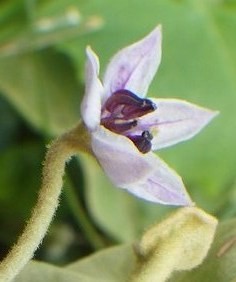Pōpolo
(Solanum oxycarpum)

Description
Solanum nelsonii (often misspelled Solanum nelsoni), common names pōpolo and Nelson's horsenettle, is a partially woody sprawling shrub-like perennial plant in the family Solanaceae, part of the Solanum or nightshade genus. This poisonous plant is endemic to the Pacific Islands. It grows low in coastal sites in coral rubble to pure sand. Solanum nelsonii was listed as an endangered species wherever found by the U.S. Fish and Wildlife Service on September 30, 2016. Pōpolo is used in restoration projects around the state of Hawaii and the Northwest Hawaiian Islands. Nelson's horsenettle was first described by Michel Félix Dunal. The scientific name Solanum nelsonii has also – invalidly – been given to two other species of nightshade: S. nelsonii of Zipp. based on Span. is the S. violaceum described by Ortega. S. nelsonii of Correll is S. oxycarpum. Several varieties of Nelson's horsenettle have been described, but they are not usually considered valid anymore: Solanum nelsonii var. acuminatum F.Br. in Christophersen & Caum Not to be confused with S. acuminatum as described by Ruiz & Pavón Jiménez. Solanum nelsonii var. caumii F.Br. In Christophersen & Caum Solanum nelsonii var. intermedium F.Br. in Christophersen & Caum Not to be confused with S. intermedium as described by Otto Sendtner in C.F.P. von Martius. Solanum nelsonii var. thomasiifolium Seem. Not to be confused with S. thomasiifolium. Solanum nelsonii var. typicum F.Br. in Christophersen & Caum Solanum nelsonii var. vadosum H.St.John Solanum is a large and diverse genus of flowering plants, which include three food crops of high economic importance: the potato, the tomato and the eggplant (aubergine, brinjal). It also contains the nightshades and horse nettles, as well as numerous plants cultivated for their ornamental flowers and fruit. Solanum species show a wide range of growing habits, such as annuals and perennials, vines, subshrubs, shrubs, and small trees. Many formerly independent genera like Lycopersicon (the tomatoes) and Cyphomandra are now included in Solanum as subgenera or sections. Thus, the genus today contains roughly 1,500–2,000 species. The generic name was first used by Pliny the Elder (AD 23–79) for a plant also known as strychnos, most likely S. nigrum. Its derivation is uncertain, possibly stemming from the Latin word sol, meaning "sun", referring to its status as a plant of the sun.
Taxonomic tree:







